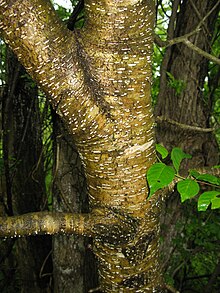Prunus buergeriana
| Prunus buergeriana | |
|---|---|

| |
| Flowers and foliage | |
| Scientific classification | |
| Kingdom: | Plantae |
| Clade: | Tracheophytes |
| Clade: | Angiosperms |
| Clade: | Eudicots |
| Clade: | Rosids |
| Order: | Rosales |
| Family: | Rosaceae |
| Genus: | Prunus |
| Subgenus: | Prunus subg. Padus |
| Species: | P. buergeriana
|
| Binomial name | |
| Prunus buergeriana | |
| Synonyms | |
| |
Prunus buergeriana,[1] in Japanese イヌザクラ (inu-zakura), meaning dog cherry, is a species of bird cherry native to Japan, Korea, Taiwan, China, northeast India (Sikkim), and Bhutan. In China it prefers to grow on mountain slopes at 1000 to 3400 m above sea level.[2] Its closest relative is Prunus perulata, from which it is morphologically and genetically distinct.[3]
Description
[edit]
Prunus buergeriana individuals usually reach a height of 6–12 metres (20–39 ft). The small flowers are borne on a raceme.[2] The fruit ripen from green through red to black.
Cultural significance
[edit]Considered an unlovely tree in Japan,[4] the dog cherry is used as a simile in Japanese haiku for unflattering comparisons with dogs; in these the paltry raceme resembles the tail of a whipped cur, or the spotted bark the markings of a starving mongrel.[4]

References
[edit]- ^ "Prunus buergeriana Miq". International Plant Names Index (IPNI). Royal Botanic Gardens, Kew; Harvard University Herbaria & Libraries; Australian National Botanic Gardens. Retrieved 11 December 2018.
- ^ a b "Padus buergeriana (Miquel) T. T. Yü & T. C. Ku, Fl. Reipubl. Popularis Sin. 38: 91. 1986". Flora of China. Retrieved 11 December 2018.
- ^ Liu, Xiao-Lin; Wen, Jun; Nie, Ze-Long; Johnson, Gabriel; Liang, Zong-Suo & Chang, Zhao-Yang (14 December 2012). "Polyphyly of the Padus group of Prunus (Rosaceae) and the evolution of biogeographic disjunctions between eastern Asia and eastern North America". Journal of Plant Research. 126 (3): 351–361. doi:10.1007/s10265-012-0535-1. PMID 23239308. S2CID 5991106.
- ^ a b Gill, Robin D (31 October 2006). Cherry Blossom Epiphany — The Poetry And Philosophy of a Flowering Tree — A selection, translation and lengthy explication of 3000 haiku, waka, senryû and kyôka about a major theme from I.P.O.O.H. (In Praise Of Olde Haiku). Paraverse Press. pp. 33–38. ISBN 9780974261867.
